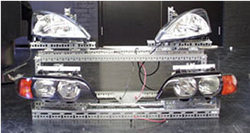The Long and Lighted Road: Lighting and Driving
Vehicle Headlighting
Headlights
It wasn't long after automobiles began to be used widely that lighting systems allowing their drivers to see at night began to be developed. Now, headlights are required equipment on all cars, and these systems must meet specific requirements standardized by the Society of Automotive Engineers (SAE) in terms of their distributions of luminous intensity and color. The distributions of luminous intensity are specified so that headlamps will illuminate the areas of the roadway important to a driver without causing excessive glare to oncoming drivers or to passers-by along the roadway. The specification of color is to ensure that colored objects like road signs can be readily distinguished. For example, a red stop sign is of more critical importance than, say, a brown tourism information sign. Because the colors are an important part of signs' messages, headlights must allow drivers to distinguish colors.
For most of their history, vehicular headlights have been developed using a single type of lighting technology: the tungsten filament lamp. The reasons for the success and longevity of tungsten filament lamps are twofold: first, these lamps are compact in size yet high in luminance (brightness), so that the optics (reflectors and lenses) around the filament can easily distribute the light into the required patterns. Such patterns would never be possible with fluorescent lamps, even though a typical 32-W T8 fluorescent lamp produces more light than a pair of conventional tungsten filament headlamps! This is because fluorescent lamps are large, diffuse sources that are not easily controlled optically.
 |
| Headlamps using halogen and high intensity discharge light sources, mounted on racks for visibility studies at the Lighting Research Center. |
During the 1990s, automobile and headlamp manufacturers introduced high intensity discharge (HID) headlamps. These sources generate light through an arc discharge that is both small in size and high in luminance. These are essentially metal halide lamps with special control gear that converts the low-voltage electrical power provided by the vehicle into the proper voltage for operating the discharge lamp. Generally, these lamps produce about twice as much light as tungsten filament headlamps. Because the maximum intensity of all headlamps is limited by the specifications described above, the extra light tends to be distributed to the periphery, and many individuals have reported that their field of view seems wider with these headlamps. (Of course, these lamps may also seem brighter to oncoming traffic.)
HID headlamps require special starting gear to operate. Metal halide lamps used in other applications, like warehouses and street lights, have long warm-up times before the lamp produces its full light output. This characteristic is not a severe limitation for these applications, but imagine having to wait several minutes for the headlights to turn on! To avoid this unacceptable situation, the ballast provided with HID headlamps also provides a very high current to the lamps when they are initially started so that they will produce enough light when first turned on. Additionally, HID headlamps are doped with xenon, a material that allows these lamps to generate sufficient light output within a short period of time.
These lamps are perhaps most distinguishable by their different color properties from tungsten filament headlamps. In comparison to the slightly yellowish color of light from conventional headlamps, HID headlamp illumination may appear bluish in tint, and the color of these lamps may appear to shift slightly as a car equipped with them passes by. This is primarily caused by chromatic aberrations at the edges of the projector lenses used in these systems, and partially because the discharge arc might not always be perfectly uniform in color, with light from different parts of the arc being distributed to different parts of the headlamp beam. It is possible that the color differences between tungsten filament and HID headlamps could be of benefit to users of HID headlamps, because several researchers have found that "bluer" light sources result in improved peripheral visibility.
HID headlamps are currently found primarily on higher-end vehicles, but their use is growing, and it is likely that HID headlamps will continue to be used on more and more vehicles. One factor that may impact their use is a consideration by the automotive industry to convert the electrical systems on vehicles from a 12 V system to 42 V. Such a system might result in increased efficiency of HID lamps, which require higher voltages to operate, with the conversion from 42 V perhaps more efficient than from 12 V.
Another headlighting innovation in development for vehicles involves "adaptive" forward lighting systems (called AFS systems in Europe). These systems offer the potential to respond to the environment or to driving conditions. Rather than a manually-switched "low" and "high" beam system as on current vehicles, adaptive lighting systems might alter the forward distribution of light, such as when making a sharp turn. In this case, an adaptive system might "bend" the beam into the turn so that the driver can see objects and potential hazards along the curve.
Introduction | Interior | Headlights | Vehicle Signals | Roadway | Traffic Signals | Links | Credits


